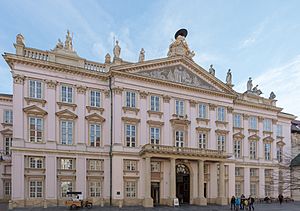Peace of Pressburg (1805) facts for kids
The Peace of Pressburg was a very important agreement. It was signed in Pressburg (which is now Bratislava, Slovakia) on December 26, 1805. This treaty brought peace between the French Emperor Napoleon Bonaparte and the Holy Roman Emperor Francis II. It happened because France had won a big battle called the Battle of Austerlitz against Russia and Austria earlier that month.
Contents
What Was the Peace of Pressburg?
The Peace of Pressburg was a treaty that ended the War of the Third Coalition. This war was a part of the larger Napoleonic Wars. After Napoleon's victory at Austerlitz, a ceasefire was agreed upon. Then, leaders from both sides met to discuss the terms of the peace.
Who Signed the Treaty?
The treaty was signed by important people from both sides. For the Austrian Empire, it was Prince Johann I Joseph, Prince of Liechtenstein and Count Ignác Gyulay. For France, it was Charles Maurice de Talleyrand, who was a top diplomat for Napoleon.
Big Changes for Austria
The treaty made some big changes for the Austrian Empire. Austria had to leave the group of countries fighting against France, known as the Third Coalition. They also had to give up a lot of their land.
Land Given to France and Its Allies
- Italy: Areas like Venetia, Istria, and Dalmatia were given to the Kingdom of Italy. Napoleon had become the king of this new kingdom earlier that year.
- Southern Germany: Austria had to give up lands in southern Germany. Some of these went to France.
- Bavaria: The region of Tyrol and Vorarlberg went to Bavaria. The city of Augsburg, which used to be independent, also became part of Bavaria.
- Other German States: Austrian lands in Swabia were given to French allies. These included the King of Württemberg and the Elector of Baden. Austria agreed to give up all claims to these German states.
Small Gain for Austria
As a small trade-off, the Austrian Empire was allowed to take over the Electorate of Salzburg. This area had been ruled by the Habsburg family since 1803. The previous ruler of Salzburg, who was the Austrian Emperor's brother, was given a new territory called the Grand Duchy of Würzburg.
The End of the Holy Roman Empire
A very important part of the treaty was that Emperor Francis II recognized the new kingly titles of the rulers of Bavaria and Württemberg. This was a big step towards the end of the Holy Roman Empire. Just a few months after the treaty was signed, Napoleon created a new group of German states called the Confederation of the Rhine. Because of this, Francis II gave up his title as Holy Roman Emperor. This ancient empire had existed for over a thousand years!
Money for France
The treaty also said that Austria had to pay France a large amount of money. This payment was 40 million francs.
Later Agreements
Some smaller issues about borders, especially along the Isonzo river, were sorted out later. This happened with another agreement called the Treaty of Fontainebleau in October 1807.



